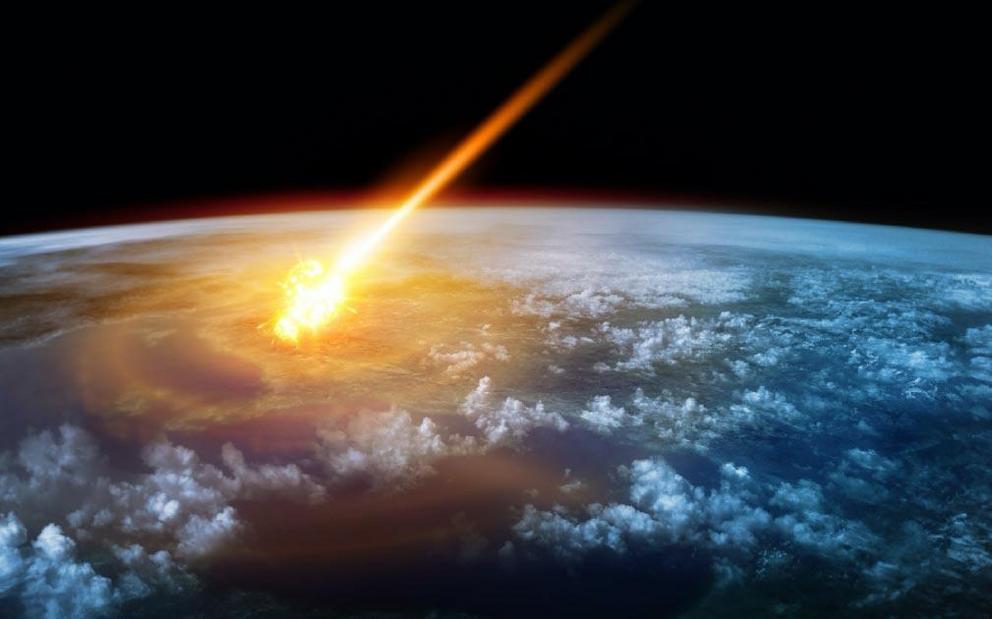Cataclysm, mass extinctions, and the consequent myths
The Earth endured a cataclysm that caused a mass extinction of many large mammals.
According to geologists, in the interval from 10,000 to 8,000 BC, some 35 to 45 species of large mammals became extinct. This is called a mass extinction . Mass extinctions can be defined as species death within a relatively short interval of time.
None of the mainstream theories which attempt to account for these great extinctions are entirely satisfactory. This is likely because orthodox geologists are operating out of the straitjacket of the theory of uniformitarianism, which suggests a rather slow, gradual change over time.
In geology, the present is key to the past. However, it’s commonly agreed that geologic time is marked by a relatively sudden change in climate about 10,000 years ago or more, from a cold glacial to warm interglacial environment.
During this time, there were catastrophic changes across the planet. For example, the asphalt and tar seeps of California, like those in South America and Africa, host a rich assemblage of evidence of faunal and floral life, the most spectacular having occurred in Rancho La Brea where the remains of numerous animals are tightly packed together.
Approximately 700 skulls of saber-toothed tigers have been systematically excavated, accompanied by a huge number of remains from horses, camels, bison, mammoths, mastodons, coyotes, wolves, sloths, and other faunal contemporaries, broken, mashed, and contorted. This suggests a sudden mass extinction where animals, predator and prey alike, were suddenly thrown together.
The Beresovka mammoth in Siberia was found with daises in its stomach. The intense refrigeration of this mammoth and others suggests that this happened very suddenly.
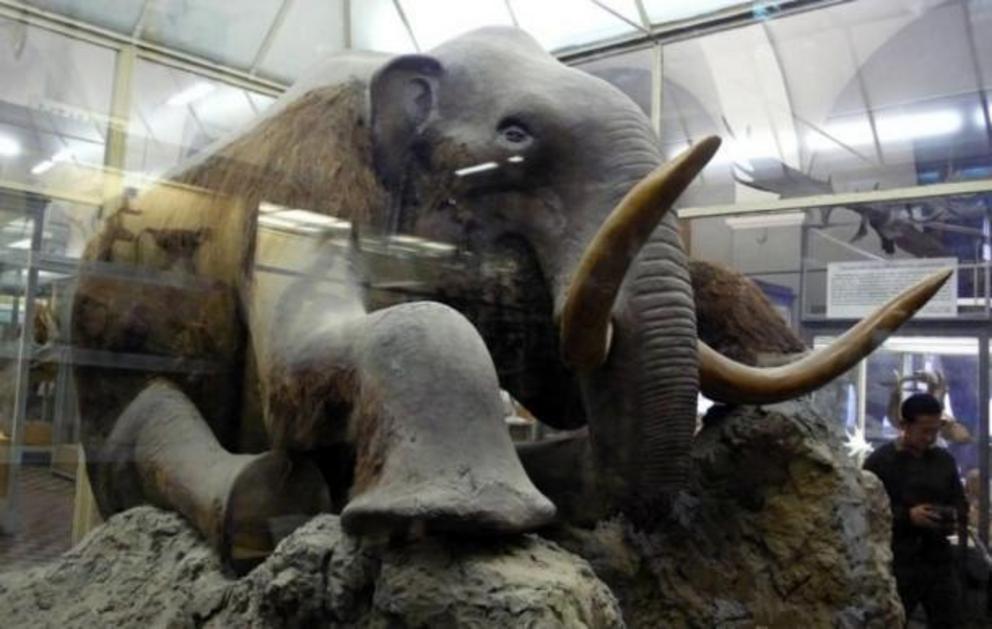 The Beresovka mammoth, except for head, it is an almost wholly preserved, mummified mammoth carcass discovered in Siberia.
The Beresovka mammoth, except for head, it is an almost wholly preserved, mummified mammoth carcass discovered in Siberia.
It froze the ground solid, turned lake and ground water into great lenses of ice, and froze dead and dying animals and plants throughout the region into grim memorials which have survived, unchanged, in that condition, down to our own day. Among these have been the frozen carcasses of mammoths, woolly rhinoceroses, and other large mammals.
It is important to note that these mammoth carcasses represent healthy, well-nourished individuals. They do not belong to very old, degenerate, or starving animals as some have maintained.
Indeed, a deep-frozen six-month old baby mammoth carcass found in 1977 was so perfectly preserved that analysis of its blood and protein, and its tissues were used for genetic studies. Interestingly, the date for its demise was determined to be about 12,000 years ago.
 The frozen mammoth calf "Lyuba" which still had food in its stomach.
The frozen mammoth calf "Lyuba" which still had food in its stomach.
The frozen mammoth flesh was described as fibrous and marbled with fat and looked as fresh as well-frozen beef. Excellent soup was made from the meat of some frozen mammoth carcasses, and the meat itself was apparently cooked and eaten.
The area where mammoths once lived is today called the tundra, where the average annual temperature is only two degrees above zero. It is treeless and the ground is frozen for 10 months of the year.
Where did these huge animals get enough to eat, considering the adult elephant can consume up to about 350 pounds of food daily? In addition, mastodons have been found deep frozen next to the carcasses of mammoths in Alaska, as well as the remains of horses, squirrels, and rhinoceroses.
Theories of Mass Extinction: The Clovis People
In an attempt to explain the extinction of so many species of land animals during this period, mainstream scientists have put forward a number of theories. One theory postulates that overhunting by early man was the cause. This is the most popular theory today.
It is believed that the Clovis people , hunters and gatherers, who suddenly emerged into prominence about 11,500 BC were responsible for the great extinctions. This is because, compared to the indigenous people of North America , the immigrant Clovis people were more numerous and more advanced in their hunting methods.
It is theorized they hunted many large mammals, or megafauna, to extinction. Their hunting amounted to overkill.
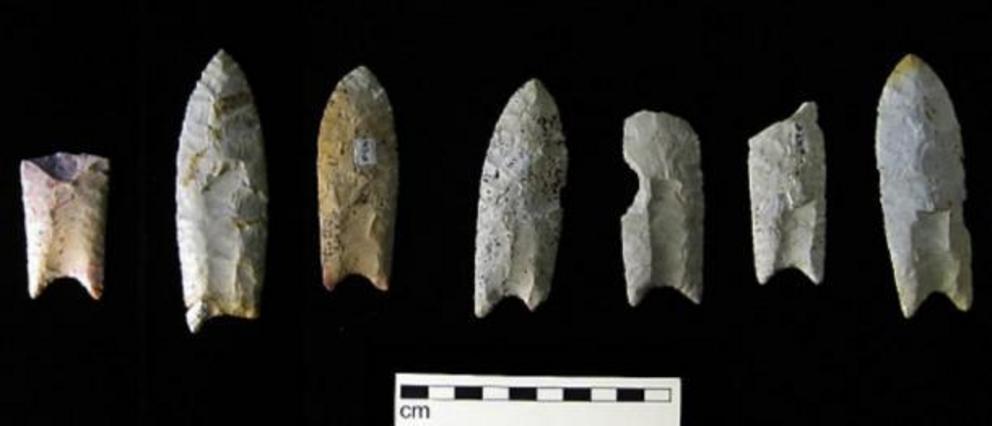 Clovis points from the Rummells-Maske Cache Site, Iowa.
Clovis points from the Rummells-Maske Cache Site, Iowa.
The most popular theory suggests that the immigrants must have gone from the arctic (Siberia) to the tropics and on to the near Antarctic regions of South America in a little over a thousand years. In addition to traveling this great distance in such a relatively short period of time, the Clovis people, seemingly ubiquitous, nearly wiped out whole large mammalian genera in the New World.
Archaeological research has yielded evidence of human occupation in the Americas as early as 32,000 years ago. Yet within 1,000 to 2,000 years after the arrival of the Clovis people, most of the big mammals were gone.
These animals, or megafauna, included mammoths, mastodons, giant ground sloths, horses, camels, giant bears, cave lions, giant bison the size of mammoths, and saber-toothed tigers. That the Clovis could wipe out most of the big mammals, predator and prey alike, in such a short period time seems a bit unlikely.
Other Theories that Account for a Cataclysmic Event
What could have caused the climate to change so suddenly? Theories that account for this are not accepted by mainstream scientists. The first theory proposed here is crustal displacement as was elucidated by Charles Hapgood in his book Earth’s Shifting Crust , later called The Path of the Pole .
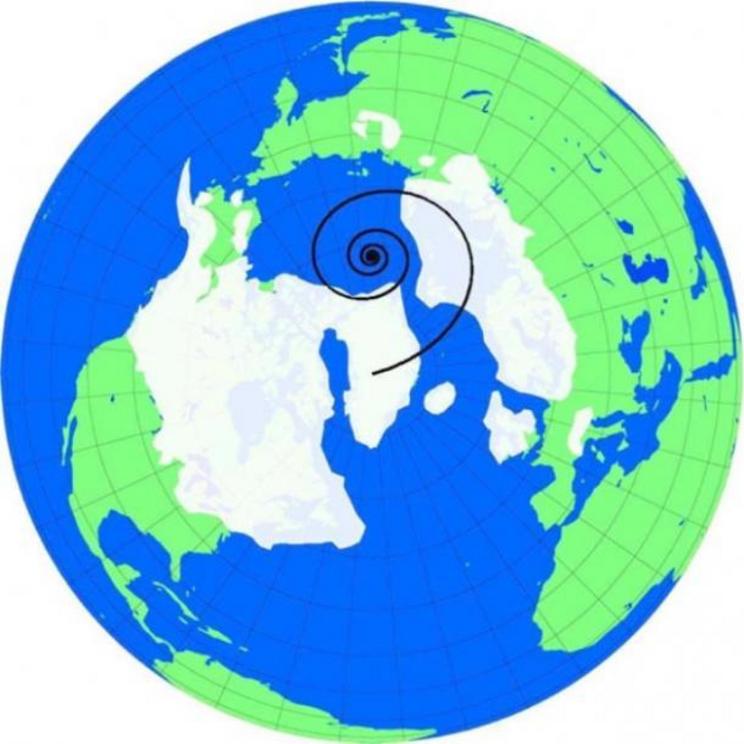 The ice cover of the Last Glacial Maximum, about 20,000 years ago, is asymmetric with respect to the present position of the North Pole in the Arctic Sea. The North Pole was presumedly positioned in Greenland. A modeled path of a rapid polar shift is show
The ice cover of the Last Glacial Maximum, about 20,000 years ago, is asymmetric with respect to the present position of the North Pole in the Arctic Sea. The North Pole was presumedly positioned in Greenland. A modeled path of a rapid polar shift is show
One intriguing question is why so many of the large mammal carcasses are found so far north. In fact, their numbers increase farther north towards the Arctic Ocean. In addition, their bones are spread over the bottom of that ocean, where ships have dredged them up.
If the pole was at Hudson Bay instead of the Arctic Circle, as it is today, Siberia and Alaska would have been south of the pole and hence in a warmer climate. These large creatures could have survived, even flourished, in such an environment.
There are thousands of well-preserved mammoth tusks that have been discovered in Siberia and which have led to a worldwide trade in ivory, which has been going on since Roman times. If the ivory tusks are exposed to the air for any length of time, they rot; and yet there are well preserved tusks from extinct animals in the Arctic area still found today.
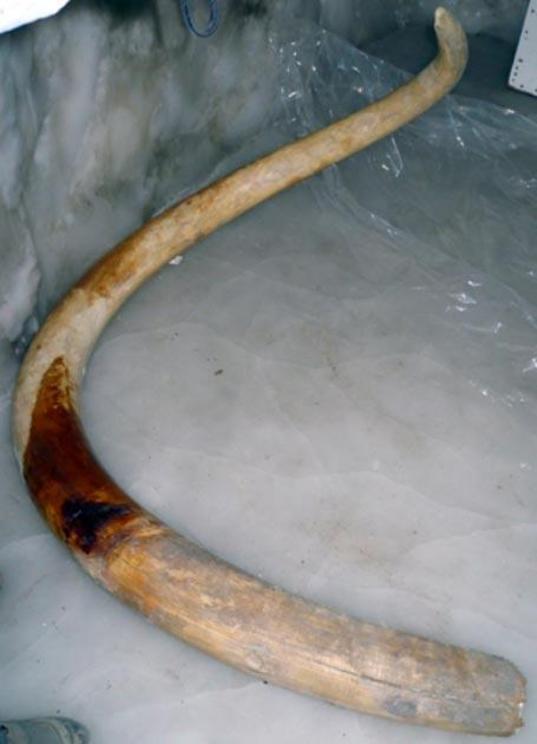 Tusk of the adult male "Yukagir mammoth".
Tusk of the adult male "Yukagir mammoth".
Some theorists have proposed that the outer crust of the Earth shifts periodically, moving some continents towards the poles and others away from them. Although this process may take up to 5,000 years, the final stages are rapid. According to this theory, the poles shifted from Hudson Bay to the Arctic Circle suddenly with dire consequences.
As a result, a crustal displacement model proposes catastrophic changes have occurred on the surface of the Earth. This theory challenges the central idea of geology: the principal of uniformitarianism, which we have already discussed.
There were earlier models of crustal displacement. One theory, purporting to explain the cause of the ice age, was due to the sliding of the lithosphere over the viscous magma underlying it through tidal friction.
Normal mantle viscosity, enhanced by powerful external influence, combined with sudden deglaciation, thus seemingly caused not only sudden crustal slippage and fracturing, volcanism, seismic activity but also a change in the actual inclination of the Earth’s spin axis. Proportional to the Earth as a whole, the crust is scarcely thicker than an onionskin is to an onion.
According to Hapgood, the last crustal displacement, around 11,500 years ago greatly affected North and South America, Australia, as well as parts of Asia. Hancock suggests some parts of Europe were impacted as well. The continent of Africa was not as greatly affected.
This is consistent with other theorists who propose that an Earth crust displacement would cause extinctions to occur on different continents at different rates as a result of varying changes in the world’s latitudes. Some continents experience great climatic change while others are largely unaffected.
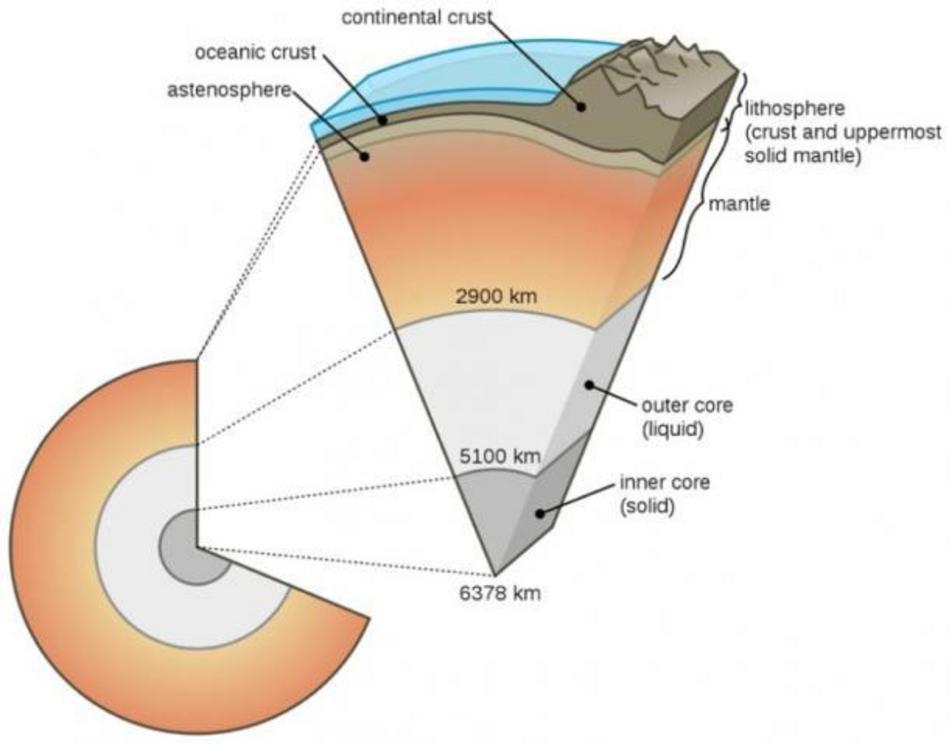 Diagram of the internal layering of the Earth showing the lithosphere above the asthenosphere (not to scale).
Diagram of the internal layering of the Earth showing the lithosphere above the asthenosphere (not to scale).
Extraterrestrial Strike
Another theory is that an extraterrestrial object struck the planet, a catastrophic event. In his book, Magicians of the Gods: The Forgotten Wisdom of Earth’s Lost Civilization , Graham Hancock proposes that a comet struck North America 12,900 years ago and then again 11,600 years ago, wiping out the Clovis people, many species of megafauna, and melted the ice caps, causing a great flood, which is also reported in so many myths. Such an event could have facilitated a crustal displacement as well, causing the poles to shift.
Hancock suggests that parts of Europe and northern South America were also impacted. This is called the Younger Dryas comet impact theory, first proposed in 2007, and it has gained the support of some mainstream scientists.
 A large enough comet could cause a cataclysm on Earth.
A large enough comet could cause a cataclysm on Earth.
It is important to mention that evidence of melted minerals such as chromite, quartz, and chert suggests temperatures were so high as to melt steel. As a result, Hancock proposes that an advanced civilization of prehistoric antiquity was obliterated from the face of the Earth during the Younger Dryas period. This has come down to us as the legend of Atlantis.
Myths of the Great Flood
Myths of a great flood are also associated with this period. A myth is defined as a traditional or legendary story, usually concerning some superhuman being or some alleged person or event, with or without a determinable basis of fact or of natural explanation.
Mythologist Joseph Campbell has said that the symbols of mythology are not manufactured; they cannot be ordered, invented, or permanently suppressed. They are spontaneous productions of the psyche, and each bear within it, undamaged, the germ power of its source.
Many legends exist about the flood. Most peoples on Earth have ancestral memories of a flood of such a magnitude and with disastrous consequences, a universal catastrophe.
Thus, flood stories are found in Asia - in India, Burma, China and Malaya, in Palestine and Mesopotamia; as well as in Australia and most of the Pacific Islands, and among the Indians of the Americas. They are rarer, although not unknown, in Europe. They are not known at all in Africa, however.
The very fact that flood stories are found among people so diverse and far apart, both in time and space, shows that their common features cannot be coincidences, being the human mind’s similar reactions to similar circumstances. Other researchers have found, however, that there are tales of cataclysmic deluges told by peoples who have never seen the sea, or lakes, or great rivers.
The Greek fear of an errant sun was expressed in the myth of the sun god Helios and his son, Phaethon, born to him by a mortal woman. According to the story, the teenager Phaethon wanted to impress his friends by driving Helios’ chariot; however, he couldn’t control the winged steeds and thus dragged the sun closer to the Earth, setting it on fire.
Helios appealed to Zeus who killed Phaethon with a thunderbolt and unleashed a great flood to drown the fire, perhaps a symbolic version of real physical events. Some accounts suggest a comet or meteor striking or coming too close to Earth, an event that could, as already mentioned, precipitate a crustal displacement, facilitating a pole shift , and consequent flood.
In fact, according to Plato, the Egyptians told his ancestor, Solon, that the truth behind the myth is that there is a deviation in the heavenly bodies that travel around the Earth, which causes huge fires that destroy what is on the Earth across vast stretches of time.
The Ojibwa of North America had a myth of a fiery comet. They describe a comet that burned everything to the ground. It was depicted as having a long white tail that scorched the Earth, ushering in a different world. According to the Ojibwa, soon after the comet, the flooding of the Earth occurred.
Similar myths can be found between widely separated cultures around the globe. For example, there are striking similarities between the Haida Gwaii of western Canada and, halfway across the world, the Sumerians.
The Haida myth states that:
Long ago, our ancestors lived in the world’s largest village. Life was carefree until the chief of the heavens decided to destroy humankind by changing the sky and bringing a worldwide flood. Survivors escaped in giant canoes, which took them to a new home, where they landed on a mountaintop. A new era began.
Here is the Sumerian myth:
Long ago our ancestors lived on the island paradise of Dilmun. Life was carefree until the flood god Enlil decided to destroy humankind by changing the sky and bringing a worldwide flood. Survivors escaped in a large ship, which took them to a new home, where they landed upon a mountaintop. A new era began.
At the end of the last ice age, mainstream scientists note, the melting of ice is believed to have raised ocean levels by some 300 feet (91 meters). Flood myths from all over the world characteristically describe scenes when humans and animals flee from the rising tides and take refuge on mountaintops.
 The Great Flood myth is a cataclysm that is prevalent in many cultures throughout the world.
The Great Flood myth is a cataclysm that is prevalent in many cultures throughout the world.
The ancient Egyptian Papyrus describes a terrible devastation created by an early cataclysm, which turned the Earth upside down. The Ermitage Papyrus , now preserved in St. Petersburg, refers to a similar ancient world convulsion, while a third Egyptian papyrus tells how the world was nearly destroyed by fire and water during a tremendous celestial upheaval long ago, when the south became north and the world turned over.
The Berbers of North Africa have a legend of a land across the sea called Attala, which was rich in tin, silver, and gold but was submerged by the sea. The Basques of northern Spain and southern France consider themselves descendants of Atlaintika, or Atlantis.
Ancient Celtic legends called the continent reclaimed by the sea, Avalon. Arabian legends refer to the land of Ad, reputed to be the seat of civilization located across the western ocean. The ancient Indian texts refer to a continent called Atyantika, which was the scene of a catastrophic destruction.
There are over 500 cultures worldwide with legends of a great deluge. Survivors include single individuals or small groups. All seemed to have been forewarned of an impending catastrophe. They escaped by seeking high ground, caves, or by means of various objects that would float.
In summing up, something catastrophic happened at the end of the last ice age. Myths by people who experienced this help us better understand what occurred.

